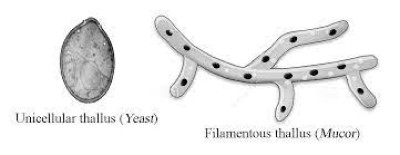THALLUS ORGANIZATION Ø
Except some unicellular forms (e.g. yeasts,
Synchytrium). Ø
The fungal body is a thallus called mycelium. Ø The mycelium is
an interwoven mass of thread-like hyphae (Sing., hypha). Ø
Hyphae may be septate (with cross wall) and aseptate (without cross wall). Ø
Some fungi are dimorphic that found as both unicellular and mycelial forms e.g.
Candida albicans.
DIFFERENT FORMS OF MYCELIUM
(a) Plectenchyma
(fungal tissue): In a fungal mycelium, hyphae organized loosely or
compactly woven to form a tissue called plectenchyma. It is two types:
i. Prosenchyma
or Prosoplectenchyma: In these fungal tissue hyphae are loosely interwoven
lying more or less parallel to each other.
ii. Pseudoparenchyma or paraplectenchyma:
In these fungal tissue hyphae are compactly interwoven looking like a
parenchyma in cross-section.
Sclerotia (Gr. Skleros=haid):
These are hard dormant bodies consist of compact hyphae protected by external
thickened hyphae. Each Sclerotium germinates into a mycelium, on return of
favourable condition, e.g., Penicillium.
Rhizomorphs:
They are root-like compactly interwoven hyphae with distinct growing tip. They
help in absorption and perennation (to tide over the unfavourable periods),
e.g., Armillaria mellea.
NUTRITION
The fungi lack chlorophyll. Therefore, they
cannot synthesize their own food. Depending on from where and how they get
nutrition, fungi are of following types: (a) Saprotrophs (= saprobes): They
obtain food from dead and decaying organic matter. They secrete digesting
enzymes to outside which digest the substratum and then absorb nutrients, e.g.,
Mucor, Rhizopus (bread mould) etc. (b) Parasitic: Ø
They obtain food from living. Ø They may be facultative or obligate. Ø
Facultative parasites grow on a variety of tissues and often cause ‘soft rot’
of the tissue, e.g., Ustilago. (In facultative mutualism, each organism can
survive independently, but it benefits both to remain together.)
Ø
The obligate- parasites absorb through specialized haustoria. (In obligate
mutualism, one organism cannot survive without the other. This term is easy to
remember because both organisms are obligated, or forced to, rely on one
another).
The
parasitic fungi that grow on surface of host cells and absorb food through
haustoria are called ectoparasites or ectophytic parasites (e.g., Mucor,
Erisphae). Ø
When parasitic fungi grow inside the host tissue arc called endoparasites or
endophytic parasites (e.g., Pythium, Puccinia). (b) Predacious: Some soil fungi
develop ring-like noses to trap annelids, nematodes etc. e.g., Arthrobotrys,
Zoophagus, Dactylella etc. (d) Symbiotic: Ø They live in
mutualistic relationship with another organism by which both are benefited. Ø
The two common examples are lichens and mycorrhiza.
Lichens
are symbiotic associations between fungi and algae. The fungal partner is a
member of ascomycetes or basidiomycetes that provides water and nutrients,
while the algal partner is a green alga or cyanobacteria that prepares food by
photosynthesis. Ø Mycorrhizas or mycorrhizae (fungus roots
in Greek) are the mutualistic symbiotic associations between soil fungi and the
roots of most plant species (95% of all plant families are predominantly
mycorrhizal). According to the carbohydrate theory (Bjorkman, 1949), the plants
that grow in soils deficient in P and N, and high intensity light develop
mycorrhizas. Ø
The two most common types of mycorrhizas are the ectomycorrhizas (ECM) and the endomycorrhizas (also
known as arbuscular mycorrhiza, AM or VAM).
The two groups are differentiated
by the fact that the hyphae of ectomycorrhizal fungi do not penetrate the cell
wall of the plant’s root cells, Ø While the hyphae of arbuscular
mycorrhizal fungi penetrate the cell.
HETEROTHALLISM
AND HOMOTHALLISM Ø
F. Blakeslee (1904) discovered
mating types or genetically distinct strains in Mucor.
He called fungi with different mating types
are called heterothallic and Ø Fungi without mating types are
called homothallic.
Nowadays we call some fungi and algae homothallic
if both male and female gametes produce in the same individual can fertilize
each other and
Heterothallic if the gametes can only be
fertilized by gametes from another individual of the same species.
What will i learn?
- On completion of this course students will be able to:. Distinguish the characteristics of different groups of fungi. Understand the mode of thallus organization and nutrition ..


Write a public review